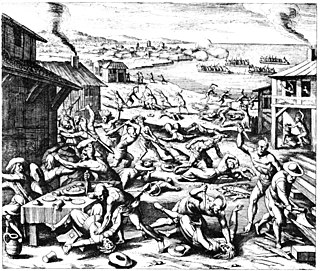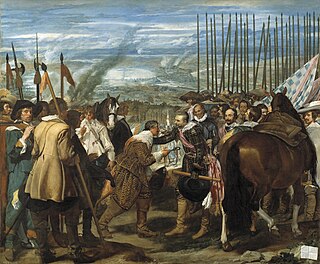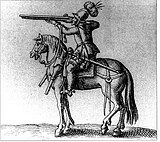
1622 (MDCXXII) was a common year starting on Saturday of the Gregorian calendar and a common year starting on Tuesday of the Julian calendar, the 1622nd year of the Common Era (CE) and Anno Domini (AD) designations, the 622nd year of the 2nd millennium, the 22nd year of the 17th century, and the 3rd year of the 1620s decade. As of the start of 1622, the Gregorian calendar was 10 days ahead of the Julian calendar, which remained in localized use until 1923.

The Battle of Nördlingen took place on 6 September 1634 during the Thirty Years' War. A combined Imperial-Spanish force inflicted a crushing defeat on the Swedish-German army.

The Battle of Rocroi, fought on 19 May 1643, was a major engagement of the Thirty Years' War between a French army, led by the 21-year-old Duke of Enghien and Spanish forces under General Francisco de Melo only five days after the accession of Louis XIV to the throne of France after his father's death. Rocroi shattered the myth of invincibility of the Spanish Tercios, the terrifying infantry units that had dominated European battlefields for the previous 120 years. The battle is therefore often considered to mark the end of Spanish military greatness and the beginning of French hegemony in Europe during the 17th century. After Rocroi, the Spanish progressively transformed the tercio system incorporating more of the line infantry doctrine used by the French over time.

The Battle of White Mountain was an important battle in the early stages of the Thirty Years' War. It led to the defeat of the Bohemian Revolt and ensured Habsburg control for the next three hundred years.

The Battle of Wimpfen took place during the Palatinate campaign period of the Thirty Years' War on 6 May 1622 near Wimpfen.

Peter Ernst, Graf von Mansfeld, or simply Ernst von Mansfeld, was a German military commander; despite being a Catholic, he fought for the Protestants during the early years of the Thirty Years' War. He was one of the leading mercenary generals of the war.

The Battle of Breitenfeld or First Battle of Breitenfeld, was fought at a crossroads near Breitenfeld approximately 8 km north-west of the walled city of Leipzig on 17 September, or 7 September, 1631. A Swedish-Saxon army led by King Gustavus Adolphus of Sweden and Saxon Elector John George I defeated an Imperial-Catholic League Army led by Generalfeldmarschall Johann Tserclaes, Count of Tilly. It was the Protestants' first major victory of the Thirty Years War.

A tercio, Spanish for "[a] third") was a military unit of the Spanish Army during the reign of the Catholic Monarchs of Spain and Habsburg Spain in the early modern period. They were the elite military units of the Spanish monarchy and the essential pieces of the powerful land forces of the Spanish Empire, sometimes also fighting with the navy.

Christian the Younger of Brunswick-Wolfenbüttel, a member of the House of Welf, titular Duke of Brunswick-Lüneburg and administrator of the Prince-Bishopric of Halberstadt, was a German Protestant military leader during the early years of the Thirty Years' War, fighting against the forces of the Imperial House of Habsburg, Habsburg Spain, and the Catholic League.

The Battle of Lutter took place on 27 August 1626 during the Thirty Years' War, south of Salzgitter, in Lower Saxony. A combined Danish-German force led by Christian IV of Denmark was defeated by Johan Tzerclaes, Count of Tilly, commanding an army of the Catholic League loyal to Emperor Ferdinand II.

The Battle of Höchst was fought between a Catholic League army led by Johan Tzerclaes, Count of Tilly and a Protestant army commanded by Christian the Younger, Duke of Brunswick-Lüneburg, close to the town of Höchst, today a suburb of the city of Frankfurt am Main. The result was a one-sided Catholic League victory. The action occurred during the Thirty Years' War.

The Battle of Dessau Bridge was a significant battle of the Thirty Years' War between Danish Protestants and the Imperial German Catholic forces on the Elbe River outside Dessau, Germany on 25 April 1626.

The siege of Breda of 1624–25 occurred during the Eighty Years' War. The siege resulted in Breda, a Dutch fortified city, falling into the control of the Army of Flanders.

Gonzalo Andrés Domingo Fernández de Córdoba was one of the main Spanish military leaders during the Eighty Years' War,[?] Thirty Years' War, and the War of the Mantuan Succession.

The Battle of Kallo was a major field battle fought from 20 to 21 June 1638 in and around the forts of Kallo and Verrebroek, located on the left bank of the Scheldt river, near Antwerp, during the second phase of the Eighty Years' War. Following the symbolic recovery of Breda during the 1637 campaign, the Dutch Republic agreed with the French Crown, with whom it had allied in 1635, to besiege a major city in the Spanish Netherlands during the 1638 campaign. The commander of the Dutch States Army, Frederick Henry of Orange, planned an approach over Antwerp from the two sides of the Scheldt. Count William of Nassau-Siegen was entrusted to land in the Spanish-controlled Waasland region, west of Antwerp, to seize the forts of Kallo and Verrebroek, along with several other key fortifications, to invest Antwerp from the west. In the meantime, Frederick Henry would advance on the opposite bank to complete the blockade of the city while the armies of France invaded the Spanish Netherlands from the south to oblige the Spanish Army of Flanders to divide its forces.

The Battle of Oldendorf on 8 July 1633 was fought as part of the Thirty Years' War between the Swedish Empire with its Protestant German allies and the Holy Roman Empire near Hessisch-Oldendorf, Lower Saxony, Germany. The result was a decisive victory for the Swedish Army and its allies.

The Army of Flanders was a multinational army in the service of the kings of Spain that was based in the Spanish Netherlands during the 16th to 18th centuries. It was notable for being the longest-serving army of the period, being in continuous service from 1567 until its disestablishment in 1706 and taking part in numerous pivotal battles of the Dutch Revolt (1566–1609) and the Thirty Years' War (1618–1648). Because it employed or pioneered many developing military concepts more reminiscent of later military units, enjoying permanent, standing regiments (tercios), barracks, military hospitals and rest homes long before they were adopted in most of Europe, the Army of Flanders has been considered the world's de facto first modern professional standing army. Sustained at huge cost and at significant distances from Spain via the Spanish Road, the Army of Flanders also became infamous for successive mutinies and its ill-disciplined activity on and off the battlefield, including the Sack of Antwerp in 1576.

The siege of Leuven was an important siege in the Thirty Years' War in which a Franco-Dutch army under Frederick Henry of Orange and the French Marshals Urbain de Maillé-Brezé and Gaspard III de Coligny, who had invaded the Spanish Netherlands from two sides, laid siege to the city of Leuven, defended by a force of 4,000 comprising local citizen and student militias with Walloons, Germans, Spanish and Irish of the Army of Flanders under Anthonie Schetz, Baron of Grobbendonck. Poor organization and logistics and the spread of sickness among the French, along with the appearance of an Imperial-Spanish relief army of 11,000 under Cardinal-Infante Ferdinand and Ottavio Piccolomini, forced the invading army to lift the siege. This failure allowed the Spanish forces to take the initiative and soon the invaders were forced into a headlong retreat.

The siege of Heidelberg or the Imperial-Spanish capture of Heildelberg took place from 23 July to 19 September 1622, at Heidelberg, Electorate of the Palatinate, between the Imperial-Spanish army led by Johan Tzerclaes, Count of Tilly and Don Gonzalo Fernández de Córdoba against the Anglo-Protestant forces of Frederick V, Elector Palatine, commanded by Sir Gerard Herbert and Sir Horace Vere during the Palatinate campaign, in the context of the Thirty Years' War. On 16 September the city of Heidelberg was taken by storm, and the Heidelberg Castle surrendered three days later to the Imperial and Spanish forces.

Johann Philipp Kratz von Scharffenstein was a German nobleman and field marshal, who fought during the course of the Thirty Years' War. He served with distinction in forces of both the Catholic League and Holy Roman Empire. His poor relationship with the Imperial generalissimo Albrecht von Wallenstein frustrated his plan of becoming the supreme commander of the League's forces. Embittered by this he defected to Sweden, where he attained the rank of field marshal. He was captured at the Battle of Nördlingen in 1634 and executed for treason a year later.

























